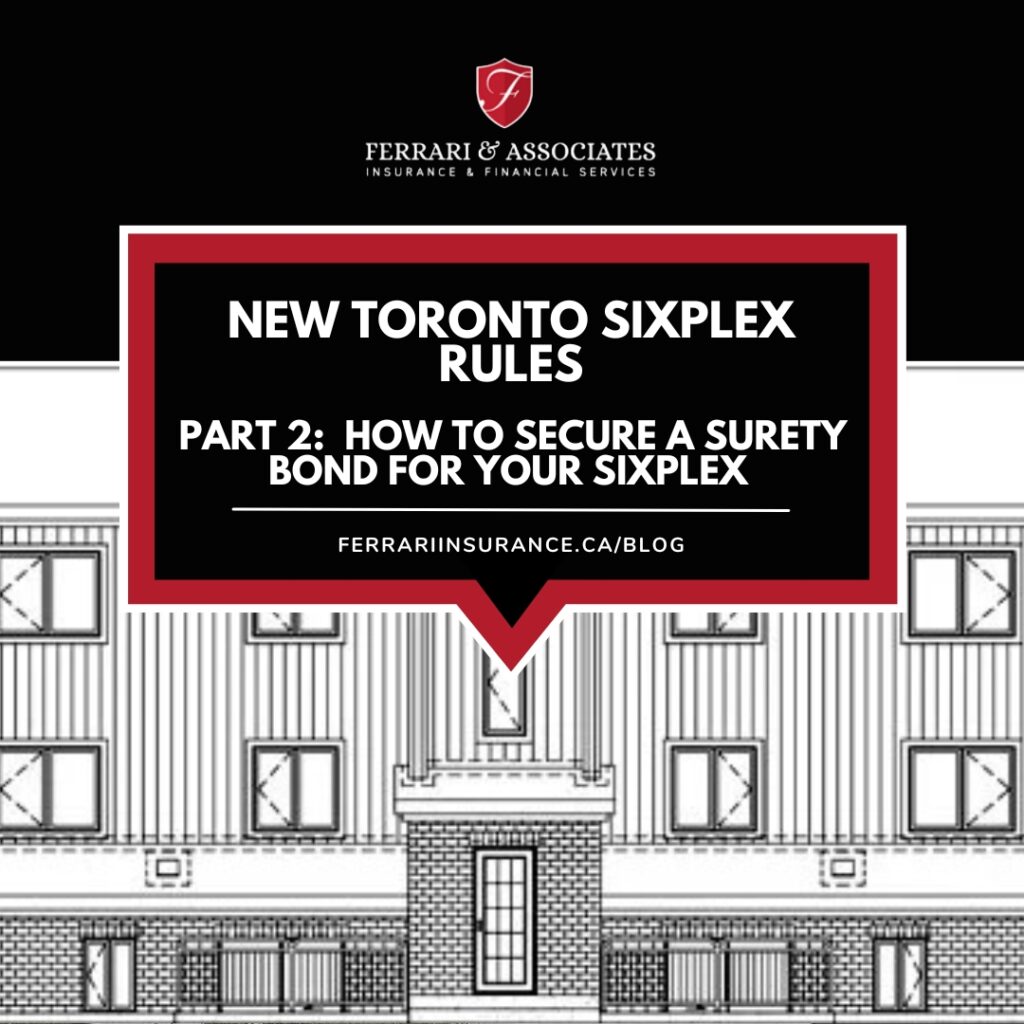In the first part of this expert blog series, the key zoning changes that now facilitate as-of-right sixplex developments in Toronto were examined, along with the increasing interest in CMHC’s MLI Select program as a financing avenue for these projects. For developer-builders venturing into mid-sized multi-unit construction, especially those unfamiliar with such development, one requirement often presents a challenge: the necessity of securing a contract surety bond for sixplex developments. This requirement is critical for ensuring project completion and safeguarding financial interests.

Whether the project involves constructing six rental units on a former single-family lot in Leslieville or increasing density through a laneway suite in East York, the procurement of performance and labour/material bonds is essential. These surety bonds assure lenders that contractual obligations will be met and that the construction will proceed smoothly.
Before any construction funds are released, it is mandatory to have the appropriate surety bond for sixplex developments in place, reinforcing the importance of understanding and securing such bonds early in your development process.
Here’s what you need to know to get ahead of the bonding process so your project doesn’t stall before it even starts.
What is a Surety Bond Application, Really?
“Think of a surety bond not as a form of insurance, but as a credit guarantee backed by a third party” begins Director of Surety, Kari Davis. “A surety company is essentially vouching for your ability to complete the project and pay your trades.” Before the surety does that, they’ll want a clear picture of your:
- Financial capacity
- Project planning
- Build experience
- Risk exposure
The process is a formal underwriting exercise, and you’ll need to provide detailed documentation—even for a relatively modest sixplex.
Step-by-Step: Preparing Your Bond Application for Surety Bond for Sixplex Developments
1. Assemble Your Financials
This is not the time for casual bookkeeping. Sureties will want to see:
- Two to three years of corporate and/or personal accountant-prepared financial statements*
- Current working capital (cash and liquid assets on hand)
- A breakdown of liabilities (mortgages, lines of credit, outstanding payables)
- Ownership structure (especially if you use holding companies or joint ventures)
*If your financials are unaudited or DIY, consider hiring a CPA to compile them professionally. A strong presentation here reduces risk in the eyes of the underwriter and speeds up approvals.
2. Build a Clear Project Package
Surety companies want to understand your plan in detail. Be ready to submit:
- A full set of architectural and structural drawings
- Construction budget (hard and soft costs clearly separated)
- Project timeline with key milestones
- Draw schedule aligned with your lender’s release triggers
- List of sub-trades with quotes, scopes, and timelines
If you’re the builder as well as the developer, this is especially important. Self-managed projects face higher scrutiny, so demonstrate that you have relationships in place with qualified trades, engineers, and consultants.
3. Demonstrate Your Track Record, or Borrow One
If this is your first build over four units, that doesn’t disqualify you—but it does raise questions. Underwriters will look for:
- Prior successful builds (even if smaller scale)
- Evidence of project management experience
- Site supervision structure (who’s overseeing daily work)
Partner and VP Construction, Mike Di Pinto suggests “if you don’t have a long development resume, ‘borrow it’ by bringing in experienced partners or general contractors. Make those relationships clear in your submission. Lenders and sureties both want to know that someone who’s done it before is involved.”
Work with the Surety Team at Ferrari & Associates
Not all brokers understand how to navigate bonding for real estate developers—many are focused on traditional construction firms. The Surety Team at Ferrari & Associates has the necessary experience helping:
- Developer-builders
- CMHC MLI Select participants
- Self-managed construction projects
This choice alone can cut days or even weeks off your application timeline. Our Surety Team will act as a translator between your project and the surety world.
Costing It Out: What to Budget for Bonding
Surety bonds aren’t free—but they’re often less expensive than people expect.
- Bond amounts are typically 10% of your total hard construction costs (split between performance and labour/material bonds).
- Bond premiums usually range from 0.5% to 2% of the bonded amount, depending on risk, project size, and your financial strength.
Bonding Cost Example:
If your hard costs are $2 million, you’ll need $200,000 in bond coverage. At a 1% premium, that’s $2,000 per bond, or $4,000 total.
That may sound minor, but it must be included in your financing and pro forma calculations early on. Kari adds: “waiting until construction financing is ready to close is too late—your lender will not release funds without those bonds in place.”
Timeline Matters: Avoid Delays with Early Action
The bonding process can take anywhere from 7 to 30 business days, depending on the completeness of your package and the responsiveness of your financial partners. Common causes of delay include:
- Incomplete financials
- Missing sub-trade agreements
- Unclear ownership structures
- Last-minute contractor substitutions
CMHC funding timelines are already tight. To avoid construction delays—and carrying costs on land—begin your bonding application as soon as your project budget is set and drawings are near-final.
Make Bonding a Competitive Advantage
Many small and mid-sized developers are caught off guard by bonding requirements. If you can prepare for them up front, you’re not only protecting your timeline—you’re also giving yourself an edge.
- Lenders see bonding as a risk mitigation signal
- Municipal partners see bonded builders as more credible
- Investors see confidence in your ability to complete
Put simply, being bond-ready makes you easier to work with.
From Sixplex Concept to CMHC-Financed Reality
In part one of this expert blog series, we explained “the move to allow sixplexes in Toronto was about increasing density, affordability, and purpose-built rental housing. But permission to build doesn’t mean much if the financing falls apart at the first draw.
Securing a surety bond for sixplex developments is all about understanding the bonding requirement under CMHC’s MLI Select. The requirements aren’t just a box to check. It’s a new layer of responsibility that every developer must now manage with intention in order to secure a surety bond for sixplex developments.
If you need to secure a surety bond for sixplex developments or other developer surety products, please contact Ferrari & Associates.

